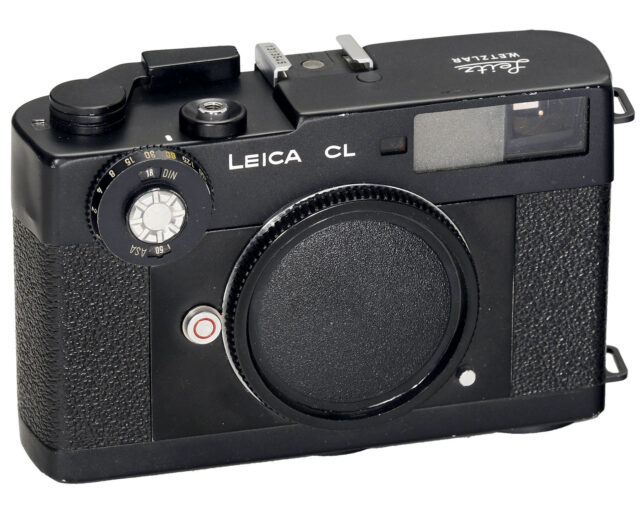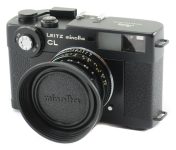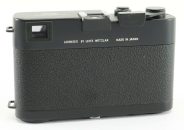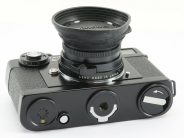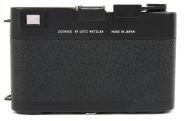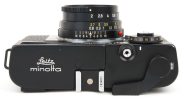Announced
Production status
Order No.
System
Leica CL
aka LEITZ minolta CL
35mm MF film rangefinder camera • Discontinued
Specification
| Format: | |
| 35mm full frame | |
Film type: | 135 cartridge-loaded film |
| Leica M [27.8mm] | |
| Shutter: | |
Type: | Focal-plane |
Model: | Mechanical |
Speeds: | 1 - 1/1000 + B |
| Exposure: | |
Exposure metering: | Through-the-lens (TTL), stop-down |
Exposure modes: | Manual |
| Rangefinder and Viewfinder: | |
Rangefinder: | Built-in, combined with viewfinder |
Viewfinder: | Built-in, combined with rangefinder |
Finder magnification: | 0.6x |
Actual rangefinder base: | 31mm |
Effective rangefinder base: | 18.6mm |
Bright-line frames: | 40mm & 50mm, 40mm & 90mm |
Parallax compensation: | Yes |
| Physical characteristics: | |
Weight: | 365g |
Dimensions: | 120x75x32mm |
| Accessories: | |
Body cap: | 14195 |
Manufacturer description #1
Introducing the Leica CL. Now there are three ways to invest in a Leica.
The Leica CL is the smallest Leica ever built. It is also the Leica that may be owned for the smallest investment.
Although it is small in size and relatively small in price, the CL should not be confused with other compact cameras. The CL was designed by the same engineers who created the Leica M-5 and Leicaflex SL, the finest 35mm cameras in the world.
The CL is built with the same care and painstaking craftsmanship that have made Leicas retain their value over the years better than any other camera. It is everything you expect a Leica to be: a superbly engineered full frame 35mm camera of unexcelled quality and precision.
The CL body measures only 1-1/4 inches thick, 3 inches high and 4-3/4 inches wide and weighs only 13 ounces.
Although the CL is not intended as the basis for a complete rangefinder camera system such as the M-5, it has features never available before in a compact camera. Or for that matter, in most full size cameras.
It is the first compact camera with interchangeable rangefinder-coupled lenses. Two lenses have been specially designed for the CL: a 40mm Summicron-C f/2 and an exceptionally compact 90mm Elmar-C f/4.
The CL will also accept most recent Leica M series lenses from 28 mm to 135 mm, and such accessories as close-up equipment and microscope adapters. With adapter rings, it can even update older thread mount lenses.
The rangefinder/viewfinder displays bright image frames for 40 mm, 50 mm, and 90 mm lenses, coupled with the focusing mechanism for automatic parallax correction.
The CL is also the first compact camera with through the lens metering. Patterned after the M-5 system, the meter measures an area large enough to integrate typical scene brightness. However, it is selective enough to permit quick, accurate readings for difficult, high contrast scenes.
As with the Leica M-5 and Leicaflex SL, Leitz technicians oversee strict quality control throughout production of the CL. Which is why, like the M-5 and the Leicaflex, the CL will take a great picture. And why, unlike any other compact camera, the Leica CL can be a great investment.
Manufacturer description #2
Compact measuring-viewfinder camera. Brightline measuring viewfinder with automatic parallax compensation. Automatically superimposed image frames for 40 and 50 as well as 90 mm focal length. Quick-changing lens bayonet as in LEICA-M models. Built-in CdS exposure meter for selective light metering through the lens. Vertically traveling focal-plane shutter from 1 to 1/1000 sec. and B. Accessory-shoe contact for electronic flash units. Onesided camera suspension. Entire camera back can be pulled off for convenient film insertion.
Rapid film change.
Serial No. from 1300001.
Manufacturer description #3
LEICA CL - The smallest rangefinder camera featuring a LEIGA bayonet lens mount and selective through-the-lens exposure metering
For all who look for maximum photographic quality at minimum cost
The new small LEICA is compact and handy - the lightest LEICA ever. That's why it's the ideal constant companion. Straightforward and easy to use, it has a proven coupled rangefinder. At a glance through the finder you instantly view the subject and all exposure data. Its selective through-the-Iens exposure metering copes with any subject, any brightness distribution. And it has a precision focal plane shutter and interchangeable lenses.
Last but not least it combines maximum optical and engineering precision in the smallest possible space. That is why the LEICA CL helps you shoot fast to capture those fleeting photographic moments in sharp, clear pictures - the LEICA way.
Creative subject control with interchangeable lenses
A fixed lens imposes limitations - interchangeable lenses overcome them. That is why the LEICA CL offers the proven LEICA bayonet lens system. With two specially developed lenses - a 40mm SUMMICRON-C f/2 and a 90mm ELMAR-C f/4 - the new CL ideally meets all needs of creative picture control with minimum effort. More than 90% of all pictures are taken with medium-focus lenses. Hence the 40mm and 90mm lenses offer the most useful practical focal length combination. Both lenses are coupled with the LEICA CL view- and rangefinder. On fitting either lens the appropriate brightline frame automatically appears in the finder.
Features and technology of a modern camera
The new LEICA CL is the last word in styling and functional technology. World-famous LEITZ engineering, based on intensive research and development and nearly half a century of LEICA experience in precision optics and mechanics, unparalleled know-how in the design of high-quality optical instruments - all these factors guarantee top photographic performance and quality in this up-to-date compact LEICA.
The reliability of LEITZ products is world famous. It stems from a tradition of meticulous attention to every detail, stringent testing, expensive special materials, constant production monitoring and final quality control by expert LEITZ engineers.
All this makes the LEICA CL unique for optical and engineering precision. And wherever you go - the LEICA name is backed by the LEITZ inter-international guarantee with world-wide servicing.
1. The precision bright-line view- and rangefinder.
The bright-line view- and rangefinder with automatic parallax compensation shows full view when wearing spectacles. The CL features at-a-glance control settings: brilliant image frames for the 40, 50 and 90mm lenses, central rangefinder field for focusing, selected shutter speed, meter needle and zero index, battery test signal. It has a finder image scale 0.6 x and a 31 .5mm rangefinder base length.
2. Up-to-date exposure metering
Selective through-the-Iens measurement with free choice of aperture/speed combination. Meter needle and zero index visible in the finder. CdS cell of 7.5mm diameter; covers approximately the rangefinder field with the 90mm lens. Measuring range: 16 EV steps from 0.5 to 32,000 cd/sq.m with f/2 lens.
Film speed settings: Adjustable from ASA 25 to 1600 (15 to 33 DIN). Power source: Interchangeable MALLORY PX 625 button cell, 1.35 volts. Lasts about 2 years with average use.
3. The silent focal plane shutter
The newly designed focal plane shutter runs vertically down the film aperture, making for maximum camera compactness. An extremely soft and vibration-free release plus the smooth shutter movement insure shake-free exposures to make the most of the famous LEITZ lens performance. Shutter speeds from 1/1000 to 1/2 sec., intermediate settings usable except between 1/30- 1/60. B setting for time exposures of any length. Automatic hot shoe flash synchronization up to 1/60 sec. with electronic flash and 1/30 sec. with flash cubes.
4. The famous LEICA bayonet lens mount
The LEICA CL uses the LEICA M bayonet mount for life-long precision . This also allows the use of numerous other LEICA lenses as well as rapid and easy lens changing.
All-metal compact body. Tough leather-type textured plastic covering. Glare-free matte black anodized top cover, front panel and camera base. Camera back fully removable in one piece with base. 1/4 inch tripod bush. Film type indicator and rewind crank in base. Carrying strap eyelets at side. Rapid film loading system, takes all standard commercial 35mm film cartridges with or without trimmed film leader. Accessory shoe with hot-shoe X contact.
Size: 4 3/4" x 3" x 1 1/4" (12 x 7.5 x 3.2 cm)
Weight: approx. 13 ozs. (365 g)
Optimum picture quality by precise focusing and exposure
To make the most of LEICA lens performance you must focus and expose exactly.
With the LEICA CL you do both instantly as you look through the finder. The precision focusing system of the LEICA CL is based on the time-proven combined double-image and split-image rangefinder.
Selective and precise exposure metering through the lens is the second outstanding LEICA CL feature. You read the correct exposure individually for every subject. You measure just the subject portion that matters and ignore misleading overbright or overdark portions. This selective metering approach permits precise "close-up" readings even at a distance.
Fascinating scope within the full LEICA system
The small LEICA CL is a worthwhile acquisition even if you already own an M-series LEICA. This is because the CL takes numerous lenses of the LEICA M range, offering a highly useful second camera body.
Even old screw-based LEICA lenses can be fitted via the bayonet/screw adapter.
If you have an old LEICA, the new LEICA CL body brings your outfit up to date - and can utilize the selective through-the-Iens exposure metering with your own LEICA lenses.
Manufacturer description #4
Only Leitz could have created the CL, a true take-it-anywhere camera with all the precision and performance of a Leica. And of all compact cameras, only the CL has Leica's 50 years of leadership in 35mm photography behind it.
Although it is small in size and relatively small in price, the CL should not be confused with other compact cameras. The CL was designed by the same engineers who created the Leica M5 and Leicaflex SL, the finest 35mm cameras in the world.
- Compact, 35mm rangefinder / viewfinder with interchangeable lenses and through-the-Iens metering.
- Uses standard 35mm film cassettes.
- Leica M bayonet mount.
- All-metal body with black anodized aluminum front panel, base and top cover; balance of back, including side, covered in black-grained plastic.
- Interchangeable Leica M lenses on the Leica CL. The bayonet lens mount of the Leica CL is identical with that of the Leica M models. Hence numerous Leica M lenses are usable on the Leica CL. In addition, older screwmount lenses can be used with the appropriate bayonet / screw adapter rings.
- The Lecia CL finder incorporates bright-line frames for the 40mm, 50mm and 90mm fields of view. The total field is approximately that for 35mm lenses, 28mm lenses require the finder.
- Standard lens, 40mm Summicron-C f/2; symmetrical Gauss type, 6 elements in 4 components; 57° diagonal angle of view; nearest focus 2 3/4 feet; aperture range f/2-f/16 with intermediate half stops.
- Long focus lens, 90mm Elmar-C f/4; triplet derivative, 4 air-spaced elements; 27° diagonal angle of view; nearest focus 3 1/3 feet; aperture range f/4-f/22 with intermediate half stops.
- Both lenses complete with lens hood, cap, rear cover, and (90mm only) soft leather pouch.
- Focal plane shutter with cloth blinds; runs vertically downward 1/1000, 1/500, 1/250, 1/125, 1/60, 1/30, 1/15, 1/8, 1/4, 1/2 second and B... intermediate settings in entire range except between 1/30 and 1/60 second.
- X-sync at all speeds up to 1/60 second for electronic flash and flash bulbs... hot-shoe contact in accessory shoe on camera body top.
- Through-the-Iens exposure metering.
- Exposure meter is a CdS cell on a swingout arm (7.5mm diam.) approximately 8mm in front of film plane... cell swings out of way as shutter release is depressed; returns to metering position upon film advancement.
- Selective (large spot) meter readings; coupled with shutter speed selection and set by zero alignment of meter needle on adjustment of lens aperture... acceptance angle is 11-1/2° with 40mm lens; 5° with 90mm lens... measuring field centered in image area: approximately double rangefinder field in finder with 40mm lens; identical with rangefinder field with 90mm lens.
- Film setting range is 25-1600 ASA, 15-33 DIN, and set on dial in center of shutter speed dial.
- System powered by 1.35 V mercury oxide button cell, PX625 or equivalent... battery test button.
- Brilliant-frame finder, 0.6 times magnification reflected image frames corresponding to view of 40mm, 50mm and 90mm lenses.
- Automatic parallax correction of frame masks... viewfinder indications and signals: (1) exposure meter needle and zero mark; (2) swing-in battery test mark; (3) red warning signal indicates meter measuring limit at certain film speeds; (4) shutter speed scale and indicator.
- Combined split-image and double-image rangefinder with measuring field in center of viewfinder.
- Camera body 4 3/4 inch long x 3 inch high x 1 1/4 inch deep, without lens; 2 5/8 inch deep with 40mm lens mounted; 4 1/8 inch deep with 90mm lens mounted; strap lugs, winding lever, accessory shoe and shutter speed dial protrude about 5 to 10mm beyond basic body dimensions.
- Camera body without lens, 13 ounces ; 40mm lens without hood, 4 1/4 ounces; 90mm lens without hood, 8 3/4 ounces.
From the editor
A smaller version of the LEICA M5 with similar TTL exposure metering system. The camera was designed in Wetzlar but manufactured by Minolta in Japan. Production ceased in 1976 after only 3 years.
In the U.S. and Europe, the camera was sold as the LEICA CL. In Japan, the camera was marketed as "LEITZ minolta CL" and supplied with two Minolta lenses manufactured in Osaka: M-ROKKOR 40/2 and M-ROKKOR 90/4.
Special editions (1)
- Leica CL "50 Jahre" (3500 units) - 1975
Similar cameras (28)
35mm full frame • Manual focus • Film • Rangefinder • Leica M mount
| Model | Shutter | Metering | Modes | Year |
|---|---|---|---|---|
| Cosina Voigtlander BESSA-R2 | M, 1/2000 | TTL • WA | M | 2002 ● |
| Cosina Voigtlander BESSA-R2A | E, 1/2000 | TTL • WA | AM | 2004 ● |
| Cosina Voigtlander BESSA-R2M | M, 1/2000 | TTL • WA | M | 2006 ● |
| Cosina Voigtlander BESSA-R3A | E, 1/2000 | TTL • WA | AM | 2004 ● |
| Cosina Voigtlander BESSA-R3M | M, 1/2000 | TTL • WA | M | 2006 ● |
| Cosina Voigtlander BESSA-R4A | E, 1/2000 | TTL • WA | AM | 2006 ● |
| Cosina Voigtlander BESSA-R4M | M, 1/2000 | TTL • WA | M | 2006 ● |
| Cosina Voigtlander BESSA-T | M, 1/2000 | TTL • WA | M | 2001 ● |
| Konica HEXAR RF | E, 1/4000 | TTL • WA | AM | 1999 ● |
| Leica M-A (Typ 127) | M, 1/1000 | -- | M | 2014 ● |
| Leica M2 | M, 1/1000 | -- | M | 1958 ● |
| Leica M3 | M, 1/1000 | -- | M | 1954 ● |
| Leica M4 | M, 1/1000 | -- | M | 1967 ● |
| Leica M4-2 | M, 1/1000 | -- | M | 1978 ● |
| Leica M4-P | M, 1/1000 | -- | M | 1981 ● |
| Leica M5 | M, 1/1000 | TTL • WA | M | 1971 ● |
| Leica M6 | M, 1/1000 | TTL • WA | M | 1984 ● |
| Leica M6 (Typ 2248) | M, 1/1000 | TTL • WA | M | 2022 ● |
| Leica M6 Panda | M, 1/1000 | TTL • WA | M | 1990 ● |
| Leica M6 Titanium | M, 1/1000 | TTL • WA | M | 1992 ● |
| Leica M6 TTL | M, 1/1000 | TTL • WA | M | 1998 ● |
| Leica M6J | M, 1/1000 | TTL • WA | M | 1994 ● |
| Leica M7 | E, 1/1000 | TTL • WA | AM | 2002 ● |
| Leica MP | M, 1/1000 | TTL • WA | M | 2003 ● |
| Leica MP Original | M, 1/1000 | -- | M | 1956 ● |
| Minolta CLE | E, 1/1000 | TTL • WA | AM | 1980 ● |
| Rollei 35 RF | M, 1/2000 | TTL • WA | M | 2002 ● |
| Zeiss Ikon | E, 1/2000 | TTL • WA | AM | 2004 ● |
